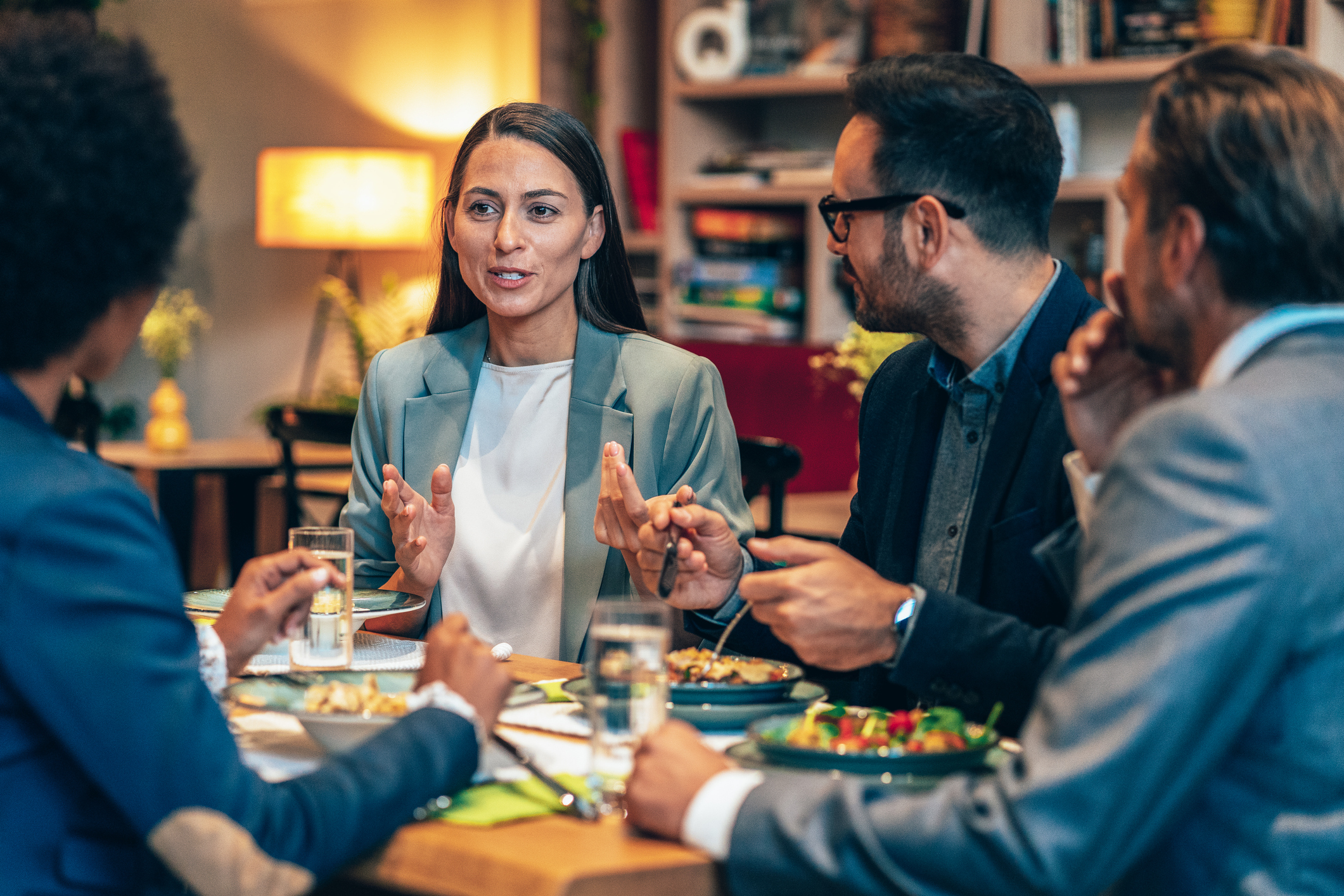How to Handle Making More—or Less—Money Than Your Friends
Over the past year, I’ve watched as one friend lost a job, another scored a life-changing bonus, two took huge pay cuts and yet another sold a home at a large profit. As for me, my financial life sort of stayed the same. But what did all this mean for my friendships? An individual change in someone’s financial situation can have ripple effects throughout our greater social groups and wider peer networks, researchers and therapists say. One person’s financial loss and another’s sudden windfall can affect the ways in which we stay connected with our friends, and fights about money can lead to personal money problems or even friend breakups.
“The perception is ‘Oh, we’re on the same path,’ and as you get older, that’s not the case,” says Blake Blankenbecler , a financial therapist and friendship educator. “There is space to talk about it with your friends. But can it be cringy to talk about? Yes. Is it important to talk about? Yes.”
Humans typically gravitate toward people who are similar to us in some way, and we cling to that sense of similarity as the friendship grows and changes, says Rebecca Adams , professor of social work at the University of North Carolina-Greensboro. Individual privileges like family money, inherited wealth and more don’t always mean that perception is accurate, of course; but at the onset of a friendship, this sameness breeds closeness.
A growing divide
When we meet in college (as I met the folks now making up one of my oldest and dearest friend groups) or deskside at a job (how I bonded with two of my newer besties) we perceive ourselves to be on equal financial footing with the people we hold close. We chased down bargain-store deals and planned ad hoc dinner parties of rent-week leftovers. During an internship in New York, my best friend and I crammed together in the world’s tiniest sublet, subsisting off Trader Joe’s coupons and our dreams for the future. But more than a decade removed from those days, our financial lives have branched in all sorts of different directions. As we grow—or not—in our respective careers, these gaps in income and wealth will only widen, says Rhaina Cohen , a podcast producer and author of the coming book on friendship, “The Other Significant Others.” But we’re also loathe to change our behaviour or discuss how these individual ups and downs will affect the glue holding the friend group together.
“In my early mid-20s, people were pretty open about what they could and couldn’t afford, and things being expensive, but I think as people have risen up the career ladder, there is less conversation about that,” Cohen says. “The awkwardness of acknowledging that people are in really different places keeps people from having those conversations. But as we get older, these divides are more likely to crop up.”
Opening up the conversation
More often than not, the friend who’s suffered a financial setback feels the burden of communicating their new needs to the group—but doing so can be much, much harder to put in practice. Ashley Appelman , a 36-year-old living in Washington, D.C., took a significant pay cut after making a big career transition a few years back. At the time, her social calendar stayed packed with numerous friends’ weddings and bachelorette parties. Rather than bow out of these commitments or suggest cheaper alternatives, she decided that putting flights on her credit card and forgoing her savings goals was worth avoiding awkward conversations and pitiful glances.
“You don’t want to disappoint people,” she says. “I have given into so many things where I didn’t really have the budget, and I just did it.”
In her four decades of financial advising, Eileen Freiburger , managing director of the Garrett Planning Network, says she has often seen people’s behaviour change after a big money move in either direction. The friend in a lower-paying job finds themselves spending far outside their means, or the pal with more in the bank feels guilty after picking the expensive restaurant for dinner.
“Who you surround yourself with and your own value system will actively impact the next stages of how you handle your money,” Freiburger says. “Are you picking up those tabs because suddenly you can? Are you trying to spend with the Joneses?”
From her perspective, she has seen immense value in holding on to people who can ground you in your original values system, the rules you lived by before these “life happens” moments rocked your financial life. Sometimes, these people are the old friends from before; other times, they’re new friends you make after.
Finding the path forward
Financial advisers and friendship educators agree: Whichever side of the financial divide you now find yourself, the way forward for many true friendships is having more open, honest conversations about money and how it affects our relationships. These don’t have to be scary or stilted discussions, Cohen says, and they don’t have to happen in overtly formal, intimidating settings.
She recommends using a real-life example to open up a bigger conversation. For instance, if you’re buying tickets to an event, ask your friend how much money they plan to spend and why. That, in turn, can kick off a much deeper conversation about your relative finances. Cohen recommends a thoughtful line that struck me as especially empathetic and easy: “What would be helpful from me to make sure we’re on the same page about what we do together and how we spend money?’”
“There is so much that goes unsaid in friendship,” she says. “What I would want people to do is talk, to have open conversations with their friends about big transitions and big differences.”
Personally, I’ve been the friend in both positions: the richer friend and the definitely-not-rich one. I recently passed on a luxe vacation with one set of dear friends. I agonised over the decision, fantasising about suddenly finding a great flight deal or stumbling upon a can’t-miss hotel deal. After enough hours staring at travel booking sites, though, I knew my budget just couldn’t stomach it. And even though my friends understood—and of course they did! They’re good friends for a reason!—I had to hype myself up to send the “Hey guys, I’ve been thinking about our trip…” text.
Admitting I had to back out felt like a tiny failure, like I wasn’t as committed to the friendship as I had been in years past. But when another pal recently took a large pay cut as she pursued a more demanding—and lower-paying—career, I found myself on the other side of the table. After a handful of conversations about her reduced salary and inflexible schedule, I remembered my own struggle to send that text. I took the initiative to bring up the new discrepancy, suggesting we move our usual dinner-and-drinks hangouts to a lower-key TV night in. Six months later, I have to say: Both of our budgets are happier for it.
 Copyright 2020, Dow Jones & Company, Inc. All Rights Reserved Worldwide. LEARN MORE
Copyright 2020, Dow Jones & Company, Inc. All Rights Reserved Worldwide. LEARN MORE
This stylish family home combines a classic palette and finishes with a flexible floorplan
Just 55 minutes from Sydney, make this your creative getaway located in the majestic Hawkesbury region.
Continued stagflation and cost of living pressures are causing couples to think twice about starting a family, new data has revealed, with long term impacts expected
Australia is in the midst of a ‘baby recession’ with preliminary estimates showing the number of births in 2023 fell by more than four percent to the lowest level since 2006, according to KPMG. The consultancy firm says this reflects the impact of cost-of-living pressures on the feasibility of younger Australians starting a family.
KPMG estimates that 289,100 babies were born in 2023. This compares to 300,684 babies in 2022 and 309,996 in 2021, according to the Australian Bureau of Statistics (ABS). KPMG urban economist Terry Rawnsley said weak economic growth often leads to a reduced number of births. In 2023, ABS data shows gross domestic product (GDP) fell to 1.5 percent. Despite the population growing by 2.5 percent in 2023, GDP on a per capita basis went into negative territory, down one percent over the 12 months.
“Birth rates provide insight into long-term population growth as well as the current confidence of Australian families,” said Mr Rawnsley. “We haven’t seen such a sharp drop in births in Australia since the period of economic stagflation in the 1970s, which coincided with the initial widespread adoption of the contraceptive pill.”
Mr Rawnsley said many Australian couples delayed starting a family while the pandemic played out in 2020. The number of births fell from 305,832 in 2019 to 294,369 in 2020. Then in 2021, strong employment and vast amounts of stimulus money, along with high household savings due to lockdowns, gave couples better financial means to have a baby. This led to a rebound in births.
However, the re-opening of the global economy in 2022 led to soaring inflation. By the start of 2023, the Australian consumer price index (CPI) had risen to its highest level since 1990 at 7.8 percent per annum. By that stage, the Reserve Bank had already commenced an aggressive rate-hiking strategy to fight inflation and had raised the cash rate every month between May and December 2022.
Five more rate hikes during 2023 put further pressure on couples with mortgages and put the brakes on family formation. “This combination of the pandemic and rapid economic changes explains the spike and subsequent sharp decline in birth rates we have observed over the past four years,” Mr Rawnsley said.
The impact of high costs of living on couples’ decision to have a baby is highlighted in births data for the capital cities. KPMG estimates there were 60,860 births in Sydney in 2023, down 8.6 percent from 2019. There were 56,270 births in Melbourne, down 7.3 percent. In Perth, there were 25,020 births, down 6 percent, while in Brisbane there were 30,250 births, down 4.3 percent. Canberra was the only capital city where there was no fall in the number of births in 2023 compared to 2019.
“CPI growth in Canberra has been slightly subdued compared to that in other major cities, and the economic outlook has remained strong,” Mr Rawnsley said. “This means families have not been hurting as much as those in other capital cities, and in turn, we’ve seen a stabilisation of births in the ACT.”
This stylish family home combines a classic palette and finishes with a flexible floorplan
Just 55 minutes from Sydney, make this your creative getaway located in the majestic Hawkesbury region.






















